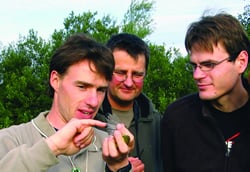Does ringing affect birds?
Ringing has little effect on birds because relative to the bird’s weight, wearing a ring is similar to a person wearing a watch. It is essential that birds are not affected unduly by the fitting and wearing of a ring; if they were, ringing would not tell us how normal birds behave.
Many studies have shown that birds ringed during the breeding season quickly return to incubating eggs, or feeding chicks, once they are released, and long distance migrants continue to travel thousands of miles between breeding and wintering grounds.
How are birds caught for ringing?
The method most frequently used to catch fully-grown birds is the mist net, erected between poles, and is designed to catch birds in flight. Birds can only be removed safely from mist nets by experienced ringers who have received special training. About twenty percent are ringed as chicks in the nest; this is valuable because their precise age and origin are known.
Learning to ring
Ringing is carried out by skilled ringers with the utmost consideration for the birds’ welfare and can only be learnt by practice under the close supervision of experienced ringers.
You learn as an 'apprentice' for at least one or two years, but usually rather longer depending on the person training and how much time they have to ring. Essential skills include the safe and efficient catching and handling of birds, identification, ageing, measuring and record keeping.
Progress is assessed by an independent ringer so the BTO Ringing Scheme maintains very high standards of bird welfare and scientific data. A BTO ringing permit is also a legal requirement for anyone ringing birds. It has to be renewed annually.
Who rings?
Bird ringers come in many guises, from individuals working in urban areas, to large groups working in a wide geographic area - with ages ranging from under 10 to over 80. Young ringers can start to train as soon as their potential Trainer feels they are ready - there is no lower (or upper) age limit.
What do sessions involve?
Depending where you are, you could get involved with ringing seabirds on Scottish islands, owl chicks in nest boxes or catch a variety of passage migrants on the coast, tits or finches early on winter mornings or, even earlier in the morning, warblers in the breeding season.
Most ringers catch birds when they’re at their most active, which is often early in the morning, so sessions starting at 5am, or earlier, are commonplace and ringing sites can rarely be reached using public transport. A good morning’s ringing may take you through to lunchtime, but there’s always the possibility of catching birds coming to roost or even catching at night.
Planning and preparation
The ringing process involves much more than you might imagine, preparation and planning to catch and ring birds is essential. Habitat management at ringing sites, maintenance of equipment and stocking winter feeding stations are all essential jobs. Most Trainers and groups share chores with everyone getting involved. There is a lot to do and it will take up a lot of time.
Do I need to be a bird expert?
Though you don’t need to be a bird expert to ring, it does help if you have some prior bird knowledge. There’s a lot to take in when you first start training, so having to learn the difference between a Siskin and a Greenfinch when you start to ring can be taxing, but is still possible.
How long does training take?
The length of time you’ll spend as a trainee depends on what you would like to ring and how much time you have to spend ringing. Are you able to go out once a week or once a month? Do you want a full permit or a restricted permit?
A short period of training (six months) may be required for a restricted permit, but for other activities and species, you will train for at least a year, and generally longer. It is then up to your Trainer to recommend you for your C permit, which allows you to work alone, but under the remote supervision of your Trainer.
How can I start ringing?
Anyone training to ring will need to gain field experience with a qualified trainer.
How do I find a Trainer?
There are Trainers throughout the country, so if you are interested in training to ring, see How to find a ringing Trainer for instructions on how to locate one close to you.
- Please note, if you are under the age of 18 then a Trainer will only be able to take you on as a trainee if they hold a Young Persons' Training Endorsement so please DO NOT use the Find-a-Trainer functionality to contact potential Trainers; instead, contact the Ringing Unit directly at ringing.licensing [at] bto.org
What equipment do I need to start ringing?
The ringing group or Trainer will have all the other necessary equipment. However, as your training progresses you will want to buy pliers, rulers and other equipment. Initially, you can attend sessions as a helper, just to see if ringing is for you.
How do I get my first permit?
If, after a few sessions, you’re keen to carry on training, you will need to register as a trainee. All you have to do is fill out a registration form (available via your Trainer from the ringers-only pages) and get your Trainer to sign it.
Your initial permit payment will also include access to the Ringers’ Manual, which is the guide to all aspects of the Ringing Scheme. At this stage, you can also subscribe to Ringing & Migration, the Ringing Scheme’s journal.
